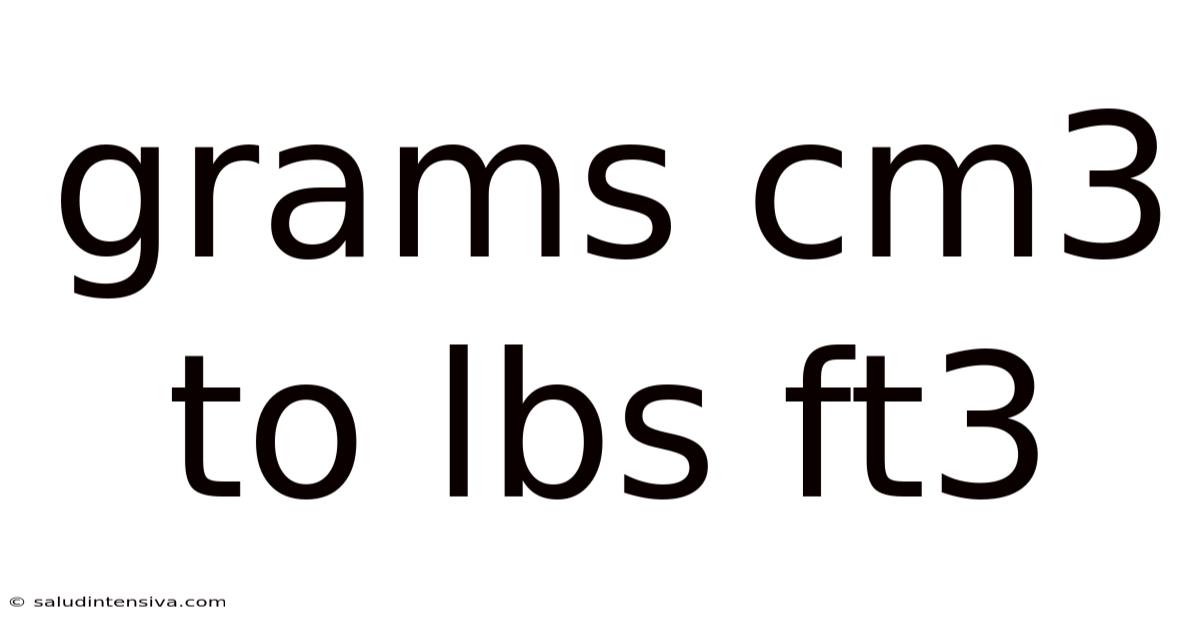Grams Cm3 To Lbs Ft3
saludintensiva
Sep 14, 2025 · 4 min read

Table of Contents
Converting Grams per Cubic Centimeter (g/cm³) to Pounds per Cubic Foot (lbs/ft³): A Comprehensive Guide
Converting units is a fundamental skill in many scientific and engineering disciplines. Understanding how to convert between different units of density, such as grams per cubic centimeter (g/cm³) and pounds per cubic foot (lbs/ft³), is crucial for accurate calculations and comparisons. This comprehensive guide will walk you through the process, explaining the underlying principles and providing practical examples to ensure a thorough understanding. This conversion is frequently needed in materials science, engineering, and even everyday applications involving volume and weight.
Introduction: Understanding Density and Units
Density is a measure of mass per unit volume. It tells us how much matter is packed into a given space. Different materials have different densities; for example, lead is much denser than wood. The units we use to express density can vary depending on the context. Grams per cubic centimeter (g/cm³) is often used in scientific settings, while pounds per cubic foot (lbs/ft³) is more common in engineering and construction. This conversion involves understanding the relationship between grams and pounds, as well as centimeters and feet.
The Conversion Factor: Breaking Down the Calculation
To convert g/cm³ to lbs/ft³, we need to consider two separate conversions:
- Mass: Converting grams (g) to pounds (lbs).
- Volume: Converting cubic centimeters (cm³) to cubic feet (ft³).
Let's examine each step individually:
-
Grams to Pounds: There are approximately 453.592 grams in one pound. Therefore, the conversion factor is: 1 lb = 453.592 g
-
Cubic Centimeters to Cubic Feet: This is a bit more complex. We know that 1 inch is equal to 2.54 centimeters (cm). To find the relationship between cubic centimeters and cubic feet, we need to cube this conversion factor:
(1 inch/2.54 cm)³ = (1 inch³/16.387 cm³)
Since there are 12 inches in a foot, 1 ft³ = (12 in)³ = 1728 in³. Therefore:
1 ft³ = 1728 in³ * (16.387 cm³/1 in³) = 28316.8 cm³
Therefore, 1 ft³ is equal to 28316.8 cm³.
The Complete Conversion Formula
Combining both conversions, the overall formula for converting g/cm³ to lbs/ft³ is:
**lbs/ft³ = (g/cm³) * (1 lb / 453.592 g) * (28316.8 cm³ / 1 ft³) **
This formula essentially multiplies the density in g/cm³ by the conversion factors for mass and volume to yield the density in lbs/ft³. We can simplify this to a single multiplier:
lbs/ft³ ≈ (g/cm³) * 62.42796
This simplified version provides a quick and accurate approximation.
Step-by-Step Conversion Example
Let's say we have a material with a density of 2.7 g/cm³. To convert this to lbs/ft³, we would use the formula:
lbs/ft³ = 2.7 g/cm³ * (1 lb / 453.592 g) * (28316.8 cm³ / 1 ft³)
lbs/ft³ ≈ 2.7 g/cm³ * 62.42796
lbs/ft³ ≈ 168.5 lbs/ft³
Therefore, a material with a density of 2.7 g/cm³ has a density of approximately 168.5 lbs/ft³.
Practical Applications and Real-World Examples
This conversion is crucial in various fields:
- Material Science: Comparing the densities of different materials for engineering applications. Choosing appropriate materials based on weight and volume requirements.
- Civil Engineering: Calculating the weight of concrete, soil, and other construction materials for structural design and load calculations.
- Chemical Engineering: Determining the density of liquids and gases for process design and optimization.
- Manufacturing: Calculating the mass of components in industrial processes.
Frequently Asked Questions (FAQ)
-
Q: Is it always necessary to use the full conversion factor (62.42796)? A: While the simplified factor provides a good approximation, using the full calculation with individual conversion factors ensures greater accuracy, especially for precise scientific or engineering applications. For general purposes, the approximation is usually sufficient.
-
Q: Can I convert lbs/ft³ to g/cm³ using the same principle? A: Absolutely! Simply reverse the formula. Divide the density in lbs/ft³ by the conversion factor (approximately 62.42796) to obtain the density in g/cm³.
-
Q: What if I have a different unit of mass or volume? A: The principle remains the same. You'll need to find the appropriate conversion factors for your specific units and apply them sequentially. Remember to ensure consistency in your units throughout the calculation.
-
Q: Are there online calculators for this conversion? A: Yes, many websites and online calculators offer this conversion functionality. However, understanding the underlying principles is crucial for accurate application and troubleshooting.
Conclusion: Mastering Unit Conversions
Converting between g/cm³ and lbs/ft³ is an essential skill in numerous scientific and engineering disciplines. Understanding the underlying conversion factors and applying the formula correctly ensures accurate calculations and comparisons. By mastering this conversion, you'll enhance your ability to solve problems involving density, mass, and volume in a wide range of applications. Remember to always double-check your calculations and choose the level of accuracy appropriate for the task at hand. The ability to confidently handle unit conversions is a testament to your foundational understanding of scientific principles and their practical applications. This skill will undoubtedly serve you well throughout your academic and professional pursuits.
Latest Posts
Latest Posts
-
Gcf For 8 And 20
Sep 14, 2025
-
Random Number 1 50
Sep 14, 2025
-
Is 12 Composite Or Prime
Sep 14, 2025
-
6 5 In Mixed Fraction
Sep 14, 2025
-
What Is 10 Of 25
Sep 14, 2025
Related Post
Thank you for visiting our website which covers about Grams Cm3 To Lbs Ft3 . We hope the information provided has been useful to you. Feel free to contact us if you have any questions or need further assistance. See you next time and don't miss to bookmark.